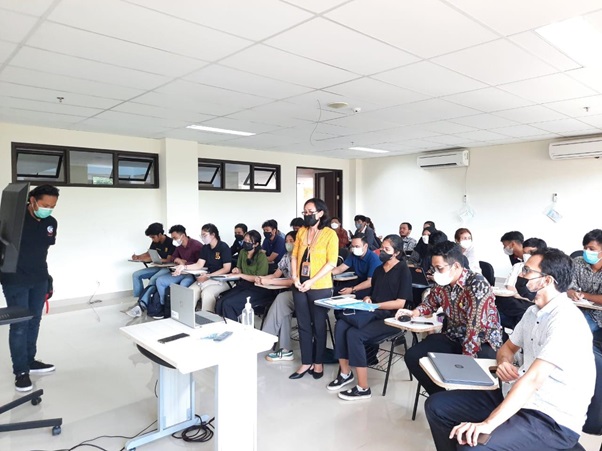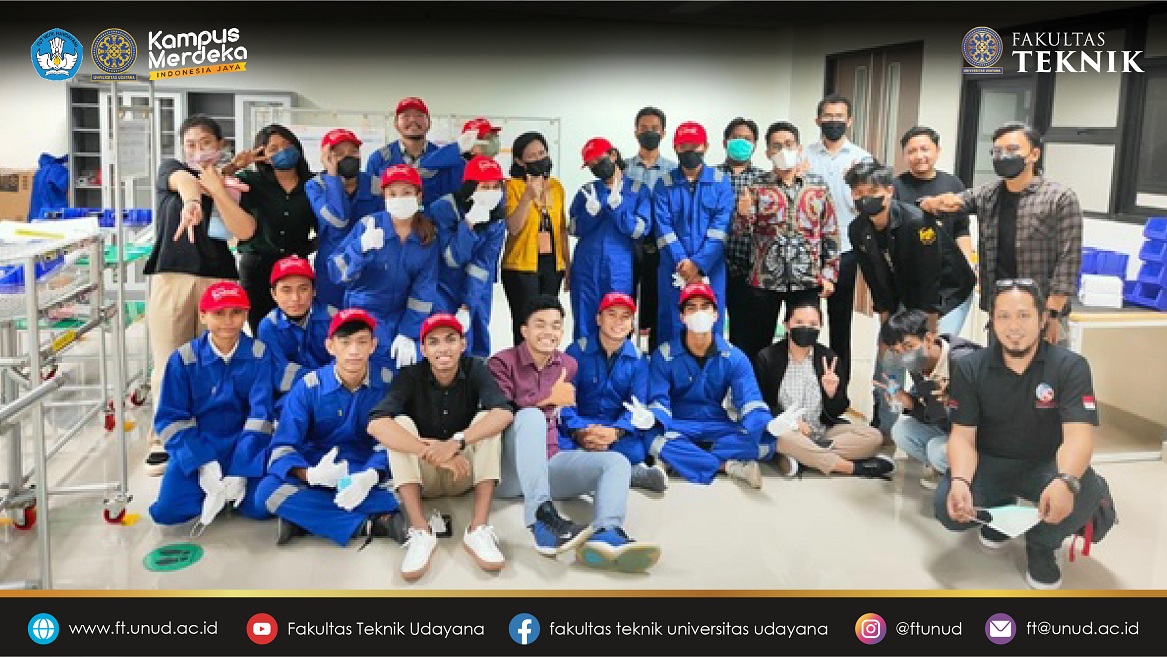Toyota Production System Training in Industrial Engineering at Udayana University by the Operation Management Development Division of PT Toyota Motor Manufacturing Indonesia
In mid-June, the Industrial Engineering Undergraduate Study Program, Faculty of Engineering, Udayana University conducted a Toyota Production System simulation training located at the Advanced Research Laboratory, Faculty of Engineering, Udayana University, Bukit Campus, Jimbaran. This simulation is carried out to provide a broader understanding to Industrial Engineering students at Udayana University regarding production systems, especially in the manufacturing sector. In its implementation, students are guided and directed directly by the Operation Management Development Division of PT. Toyota Motor Manufacturing Indonesia and accompanied by Mr. and Mrs. lecturers of Industrial Engineering, Udayana University. The Toyota Production System simulation discusses the production system in the form of a simple assembly line by implementing 2 pillars of the TPS house, namely Just in Time & Jidouka (Automation). There are six steps of the production process at TPS that have been simulated, namely from traditional production systems to continuous flow by making continuous improvements to work standardization and reducing "Young" or waste until the simulation gets the best results and production system.

The simulation begins by setting up laboratory conditions which are arranged for warehouses, workstations and distribution to customers in a simple manner like the situation in a real factory. On the first day of the simulation starting on June 21, 2022, it begins with an opening consisting of introductions from several PT. Toyota Motor Manufacturing Indonesia, which was also present, was Toyota's CSR Division and remarks from the Coordinator of the Industrial Engineering Study Program at Udayana University, namely Dr. Anak Agung Wife Agung Sri Komaladewi, S.T., M.T. At the opening, it was stated that the Toyota Sharing program is a meaningful thing for Industrial Engineering at Udayana University in order to obtain accreditation because the Industrial Engineering Study Program requires a basic lab such as the TP lab. After the opening, it was followed by lecturing in the form of material and simulation mechanisms that were given every time they started one step. The lecturing includes tools, equipment, production line mapping, and there will be new kaizen to increase effectiveness and efficiency at every step.
Starting from lecturing step 1 TPS to students, then continued with the implementation of step 1 TPS simulation. Students are given a division of labor, namely to become a simulator and observer on a regular basis. Step 1 TPS is a traditional manufacturing step where the warehouse becomes a centralized place for material stock and stock of semi-finished goods and finished goods that are ready to be sent to customers. In the step 1 simulation results, several points are obtained, namely there is waiting time, lots of product defects, and irregular transportation so that the company has a cost per unit and suffers big losses. Therefore, in step 1 the customer smile cannot be achieved.

After doing the step 1 simulation, the activity continued with lecturing the simulation material for step 2 or step stock between process. The difference with the previous step is that in step 2, each work station already has a store so that the warehouse is only a place to store materials and there is a reduction in manpower, namely 1 logistics person. After lecturing the material in step 2, it is followed by a simulation of step 2 which shows the results that there is overproduction, lack of communication between workstations and logistics people, and there is still a lot of idle time for logistics people. This causes the profit which shows a minus number and the cost per unit is still high, but slightly smaller than step 1.
The simulation for step 3 to 4 was continued on the second day, namely Wednesday, June 22, 2022 at the same location and started with lecturing the simulation material for step 3 or step pull system. Kaizen in step 3 is the existence of kanban as a production order and waiting post as a tool for visualizing information from customers. In step 3, there is also a reduction in manpower, namely 2 logistics people. The results of the step 3 simulation show that there is a significant reduction in the cost per unit and an increase in profit and it does not show a minus number (loss).

After doing the step 3 simulation, it is followed by lecturing the material for step 4 or Step Heijunka. In step 4, the company has implemented a pull system and a heijunka post as a job balancing tool. The Heijunka post is used to even out the operator's workload in step 3. After lecturing step 4, the activity continues with a simulation of step 4 with the same layout conditions as step 3 but there is an additional heijunka post on the PPIC table. From the results of the step 4 simulation, it can be seen that the cost per unit is decreasing and the profit is increasing. however, in step 4 there are still many defective items. After doing step 4, proceed with the lecturing session step 5 or the Build in Quality step. at this step prioritize the quality of the products produced, if in the previous step there were many defect products (not good products), this step has the principle; does not receive, make, and pass on not good goods by means of each workstation ensuring the point quality of its work with the help of tools such as. at this step, workstation 4 (workstation inspection) is considered unnecessary because quality checks have been carried out at each workstation.
Unlike the previous day, step 5 simulation was carried out the next day, namely on Thursday, June 23, 2022 at the same location. The simulation is done by giving a briefing beforehand to remember the lecturing session step 5 on the previous day. The simulation results for step 5 show a significant difference from the previous steps, where the cost per unit decreases and profit increases rapidly. This is due to the absence of product defects produced so as to reduce the value of company losses. After doing the step 5 simulation, the activity is continued with a lecturing session step 6 or the Continuous Flow & Standardized Work Kaizen step, where in step 6 is a continuation of step 5. next workstation. After doing lecturing step 6, immediately proceed with the simulation. in this step 6 simulation get the best simulation results where the cost per unit has a very large difference with the profit which means that at this step it can provide maximum profit for the company. Please note, Currently, PT. Toyota Motor Manufacturing Indonesia also applies a step 6 production system.
On the same day, the activity continued with independent simulation by students by repeating steps 2 and 4, the results of this independent simulation showed the same results as the previous simulation. After the independent simulation was carried out, the activity continued with a closing which began with remarks from representatives of PT Toyota Motor Manufacturing Indonesia, Mr. Wijaya said that hopefully the simulations carried out can be useful for the future and for students who have participated in the simulation it is hoped that they can share this TPS knowledge with Engineering Students Other industries, Faculty of Engineering, Udayama University. Then followed by remarks from the lecturer of the Industrial Engineering study program at Udayana University, Mr. Dr. Ir. I Ketut Gede Wirawan, M.T. and remarks by the coordinator of the Industrial Engineering study program at Udayana University, Dr. A. A. I. A Sri Komaladewi Utami, S.T., M.T., who expressed his infinite gratitude for the help and knowledge that has been given to industrial engineering students and hopes that the collaboration between PT Toyota Motor Manufacturing Indonesia and the Industrial Engineering Study Program of Udayana University can continue.









